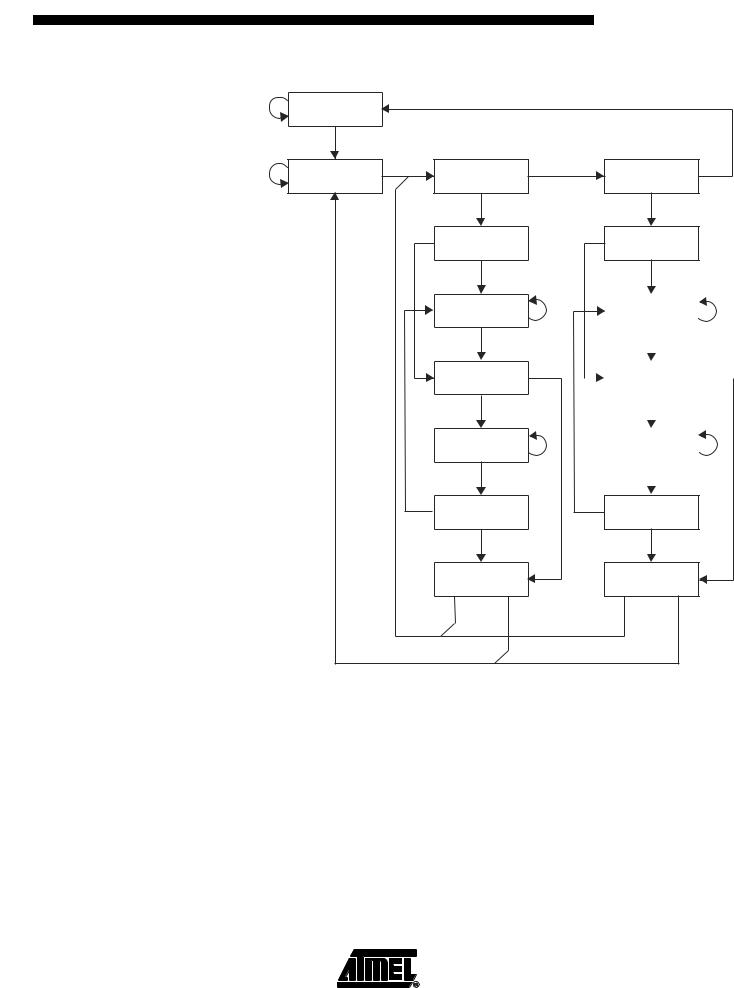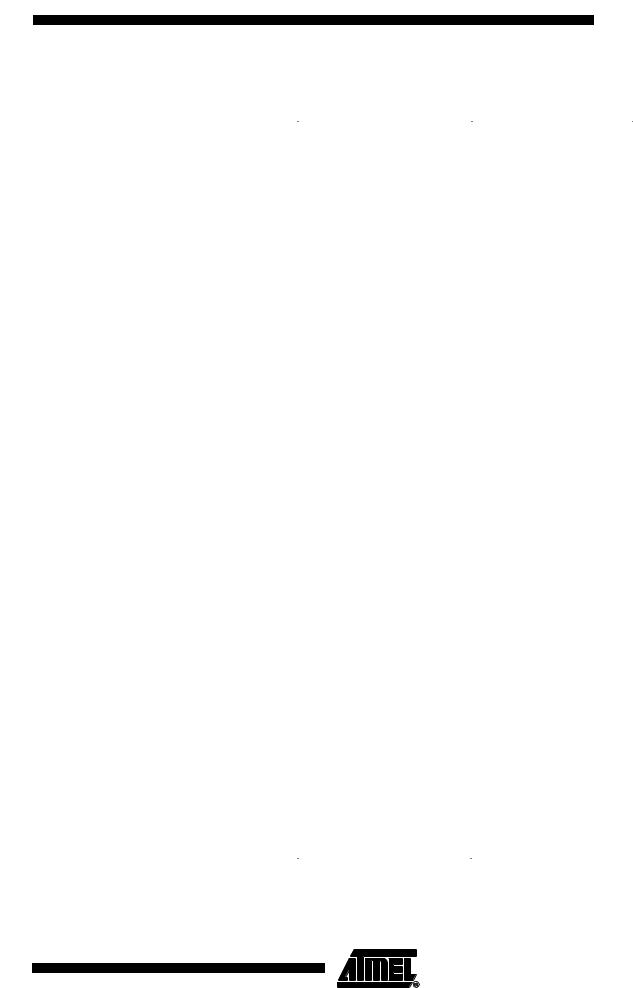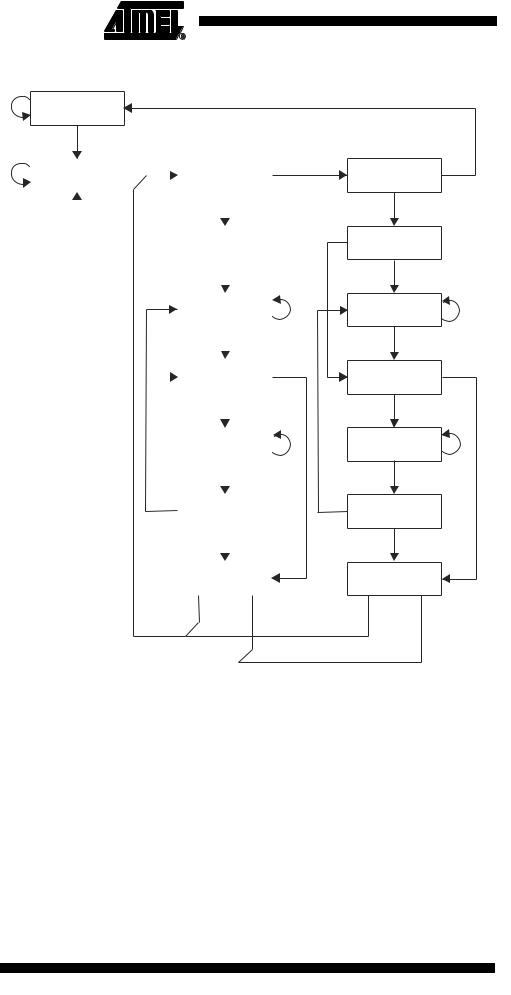
- •Features
- •Pin Configurations
- •Disclaimer
- •Overview
- •Block Diagram
- •Pin Descriptions
- •Port A (PA7..PA0)
- •Port B (PB7..PB0)
- •Port C (PC7..PC0)
- •Port D (PD7..PD0)
- •RESET
- •XTAL1
- •XTAL2
- •AVCC
- •AREF
- •AVR CPU Core
- •Introduction
- •Architectural Overview
- •Status Register
- •Stack Pointer
- •Interrupt Response Time
- •SRAM Data Memory
- •Data Memory Access Times
- •EEPROM Data Memory
- •EEPROM Read/Write Access
- •I/O Memory
- •Clock Systems and their Distribution
- •CPU Clock – clkCPU
- •I/O Clock – clkI/O
- •Flash Clock – clkFLASH
- •ADC Clock – clkADC
- •Clock Sources
- •Default Clock Source
- •Crystal Oscillator
- •External RC Oscillator
- •External Clock
- •Timer/Counter Oscillator
- •Idle Mode
- •Power-down Mode
- •Power-save Mode
- •Standby Mode
- •Extended Standby Mode
- •Analog to Digital Converter
- •Analog Comparator
- •Brown-out Detector
- •Internal Voltage Reference
- •Watchdog Timer
- •Port Pins
- •Resetting the AVR
- •Reset Sources
- •Power-on Reset
- •External Reset
- •Brown-out Detection
- •Watchdog Reset
- •Watchdog Timer
- •Interrupts
- •I/O Ports
- •Introduction
- •Configuring the Pin
- •Reading the Pin Value
- •Unconnected pins
- •Alternate Port Functions
- •Alternate Functions of Port A
- •Alternate Functions of Port B
- •Alternate Functions of Port C
- •Alternate Functions of Port D
- •Port A Data Register – PORTA
- •Port B Data Register – PORTB
- •Port C Data Register – PORTC
- •Port D Data Register – PORTD
- •External Interrupts
- •8-bit Timer/Counter0 with PWM
- •Overview
- •Registers
- •Definitions
- •Counter Unit
- •Output Compare Unit
- •Force Output Compare
- •Modes of Operation
- •Normal Mode
- •Fast PWM Mode
- •Phase Correct PWM Mode
- •Internal Clock Source
- •Prescaler Reset
- •External Clock Source
- •16-bit Timer/Counter1
- •Overview
- •Registers
- •Definitions
- •Compatibility
- •Counter Unit
- •Input Capture Unit
- •Input Capture Trigger Source
- •Noise Canceler
- •Using the Input Capture Unit
- •Output Compare Units
- •Force Output Compare
- •Modes of Operation
- •Normal Mode
- •Fast PWM Mode
- •Phase Correct PWM Mode
- •8-bit Timer/Counter2 with PWM and Asynchronous Operation
- •Overview
- •Registers
- •Definitions
- •Counter Unit
- •Output Compare Unit
- •Force Output Compare
- •Modes of Operation
- •Normal Mode
- •Fast PWM Mode
- •Phase Correct PWM Mode
- •Timer/Counter Prescaler
- •SS Pin Functionality
- •Slave Mode
- •Master Mode
- •SPI Control Register – SPCR
- •SPI Status Register – SPSR
- •SPI Data Register – SPDR
- •Data Modes
- •USART
- •Overview
- •AVR USART vs. AVR UART – Compatibility
- •Clock Generation
- •External Clock
- •Synchronous Clock Operation
- •Frame Formats
- •Parity Bit Calculation
- •USART Initialization
- •Parity Generator
- •Disabling the Transmitter
- •Receiver Error Flags
- •Parity Checker
- •Disabling the Receiver
- •Flushing the Receive Buffer
- •Asynchronous Data Recovery
- •Using MPCM
- •Write Access
- •Read Access
- •Two-wire Serial Interface
- •Features
- •TWI Terminology
- •Electrical Interconnection
- •Transferring Bits
- •START and STOP Conditions
- •Address Packet Format
- •Data Packet Format
- •Overview of the TWI Module
- •SCL and SDA Pins
- •Bit Rate Generator Unit
- •Bus Interface Unit
- •Address Match Unit
- •Control Unit
- •TWI Register Description
- •TWI Bit Rate Register – TWBR
- •TWI Control Register – TWCR
- •TWI Status Register – TWSR
- •TWI Data Register – TWDR
- •Using the TWI
- •Transmission Modes
- •Master Transmitter Mode
- •Master Receiver Mode
- •Slave Receiver Mode
- •Slave Transmitter Mode
- •Miscellaneous States
- •Analog Comparator
- •Analog Comparator Multiplexed Input
- •Features
- •Operation
- •Starting a Conversion
- •Differential Gain Channels
- •Changing Channel or Reference Selection
- •ADC Input Channels
- •ADC Voltage Reference
- •ADC Noise Canceler
- •Analog Input Circuitry
- •ADC Accuracy Definitions
- •ADC Conversion Result
- •ADLAR = 0
- •ADLAR = 1
- •Features
- •Overview
- •Test Access Port – TAP
- •TAP Controller
- •PRIVATE0; $8
- •PRIVATE1; $9
- •PRIVATE2; $A
- •PRIVATE3; $B
- •Bibliography
- •Features
- •System Overview
- •Data Registers
- •Bypass Register
- •Device Identification Register
- •Reset Register
- •Boundary-scan Chain
- •EXTEST; $0
- •IDCODE; $1
- •SAMPLE_PRELOAD; $2
- •AVR_RESET; $C
- •BYPASS; $F
- •Scanning the Digital Port Pins
- •Scanning the RESET Pin
- •Scanning the Clock Pins
- •Scanning the ADC
- •Features
- •Application Section
- •BLS – Boot Loader Section
- •Read-While-Write and no Read-While-Write Flash Sections
- •Boot Loader Lock Bits
- •Performing a Page Write
- •Using the SPM Interrupt
- •Setting the Boot Loader Lock Bits by SPM
- •Reading the Fuse and Lock Bits from Software
- •Preventing Flash Corruption
- •Fuse Bits
- •Latching of Fuses
- •Signature Bytes
- •Calibration Byte
- •Signal Names
- •Parallel Programming
- •Enter Programming Mode
- •Chip Erase
- •Programming the Flash
- •Programming the EEPROM
- •Reading the Flash
- •Reading the EEPROM
- •Programming the Lock Bits
- •Reading the Signature Bytes
- •Reading the Calibration Byte
- •SPI Serial Downloading
- •Data Polling Flash
- •Data Polling EEPROM
- •AVR_RESET ($C)
- •PROG_ENABLE ($4)
- •PROG_COMMANDS ($5)
- •PROG_PAGELOAD ($6)
- •PROG_PAGEREAD ($7)
- •Data Registers
- •Reset Register
- •Programming Enable Register
- •Virtual Flash Page Read Register
- •Programming Algorithm
- •Entering Programming Mode
- •Leaving Programming Mode
- •Performing Chip Erase
- •Programming the Flash
- •Reading the Flash
- •Programming the EEPROM
- •Reading the EEPROM
- •Programming the Fuses
- •Programming the Lock Bits
- •Reading the Signature Bytes
- •Reading the Calibration Byte
- •Electrical Characteristics
- •Absolute Maximum Ratings*
- •DC Characteristics
- •External Clock Drive Waveforms
- •External Clock Drive
- •Two-wire Serial Interface Characteristics
- •ADC Characteristics
- •Register Summary
- •Instruction Set Summary
- •Ordering Information
- •Packaging Information
- •Errata
- •ATmega32 Rev. A
- •Datasheet Change Log for ATmega32
- •Changes from Rev. 2503E-09/03 to Rev. 2503F-12/03
- •Changes from Rev. 2503D-02/03 to Rev. 2503E-09/03
- •Changes from Rev. 2503C-10/02 to Rev. 2503D-02/03
- •Changes from Rev. 2503B-10/02 to Rev. 2503C-10/02
- •Changes from Rev. 2503A-03/02 to Rev. 2503B-10/02
- •Table of Contents

ATmega32(L)
Figure 138. State Machine Sequence for Changing the Instruction Word
1 |
Test-Logic-Reset |
|
|
|
|
|
|
0 |
|
|
|
|
|
0 |
Run-Test/Idle |
1 |
|
Select-DR Scan |
1 |
|
|
|
|
||||
|
|
|
|
|||
|
|
|
|
0 |
|
|
|
|
|
1 |
Capture-DR |
|
|
|
|
|
|
|
|
|
|
|
|
|
0 |
|
|
|
|
|
|
Shift-DR |
|
0 |
|
|
|
|
1 |
|
|
|
|
|
|
Exit1-DR |
|
1 |
|
|
|
|
|
|
|
|
|
|
|
0 |
|
|
|
|
|
|
Pause-DR |
|
0 |
|
|
|
|
1 |
|
|
|
|
|
0 |
Exit2-DR |
|
|
|
|
|
|
|
|
|
|
|
|
|
1 |
|
|
|
|
|
|
Update-DR |
|
|
|
|
|
|
1 |
0 |
|
1
Select-IR Scan
0
1
Capture-IR
0
|
Shift-IR |
0 |
|
|
|
|
|
|
|
1 |
|
|
|
|
|
|
|
|
1 |
|
Exit1-IR |
||
|
|
||
|
|
|
|
|
|
0 |
|
|
|
|
|
|
|
|
0 |
|
Pause-IR |
||
|
|
|
|
|
|
1 |
|
|
|
|
|
0
Exit2-IR
1
Update-IR
1 0
AVR_RESET ($C) |
The AVR specific public JTAG instruction for setting the AVR device in the Reset mode |
||||
|
or taking the device out from the Reset Mode. The TAP controller is not reset by this |
||||
|
instruction. The one bit Reset Register is selected as Data Register. Note that the Reset |
||||
|
will be active as long as there is a logic “one” in the Reset Chain. The output from this |
||||
|
chain is not latched. |
||||
|
The active states are: |
||||
|
• Shift-DR: The Reset Register is shifted by the TCK input. |
||||
PROG_ENABLE ($4) |
The AVR specific public JTAG instruction for enabling programming via the JTAG port. |
||||
|
The 16-bit Programming Enable Register is selected as Data Register. The active states |
||||
|
are the following: |
||||
|
• Shift-DR: The programming enable signature is shifted into the Data Register. |
||||
|
• Update-DR: The programming enable signature is compared to the correct value, |
||||
|
and Programming mode is entered if the signature is valid. |
||||
|
|
|
|
|
|
|
|
|
|
|
273 |
2503F–AVR–12/03 |
|
|
|
|
|
|
|
|
|
|
|

PROG_COMMANDS ($5) |
|
|
|
|
|
|
|
|
|
|
|
|
|
|
|
The AVR specific public JTAG instruction for entering programming commands via the |
|||||||
|
JTAG port. The 15-bit Programming Command Register is selected as Data Register. |
||||||
|
The active states are the following: |
||||||
|
• Capture-DR: The result of the previous command is loaded into the Data Register. |
||||||
|
• Shift-DR: The Data Register is shifted by the TCK input, shifting out the result of the |
||||||
|
|
previous command and shifting in the new command. |
|||||
|
• Update-DR: The programming command is applied to the Flash inputs |
||||||
|
• Run-Test/Idle: One clock cycle is generated, executing the applied command (not |
||||||
|
|
always required, see Table 117 below). |
|||||
PROG_PAGELOAD ($6) |
The AVR specific public JTAG instruction to directly load the Flash data page via the |
||||||
|
JTAG port. The 1024 bit Virtual Flash Page Load Register is selected as Data Register. |
||||||
|
This is a virtual scan chain with length equal to the number of bits in one Flash page. |
||||||
|
Internally the Shift Register is 8-bit. Unlike most JTAG instructions, the Update-DR state |
||||||
|
is not used to transfer data from the Shift Register. The data are automatically trans- |
||||||
|
ferred to the Flash page buffer byte by byte in the Shift-DR state by an internal state |
||||||
|
machine. This is the only active state: |
||||||
|
• Shift-DR: Flash page data are shifted in from TDI by the TCK input, and |
||||||
|
|
automatically loaded into the Flash page one byte at a time. |
|||||
|
Note: |
The JTAG instruction PROG_PAGELOAD can only be used if the AVR device is the first |
|||||
|
|
|
device in JTAG scan chain. If the AVR cannot be the first device in the scan chain, the |
||||
|
|
|
byte-wise programming algorithm must be used. |
||||
PROG_PAGEREAD ($7) |
The AVR specific public JTAG instruction to read one full Flash data page via the JTAG |
||||||
|
port. The 1032 bit Virtual Flash Page Read Register is selected as Data Register. This is |
||||||
|
a virtual scan chain with length equal to the number of bits in one Flash page plus 8. |
||||||
|
Internally the Shift Register is 8-bit. Unlike most JTAG instructions, the Capture-DR |
||||||
|
state is not used to transfer data to the Shift Register. The data are automatically trans- |
||||||
|
ferred from the Flash page buffer byte by byte in the Shift-DR state by an internal state |
||||||
|
machine. This is the only active state: |
||||||
|
• Shift-DR: Flash data are automatically read one byte at a time and shifted out on |
||||||
|
|
TDO by the TCK input. The TDI input is ignored. |
|||||
|
Note: |
The JTAG instruction PROG_PAGEREAD can only be used if the AVR device is the first |
|||||
|
|
|
device in JTAG scan chain. If the AVR cannot be the first device in the scan chain, the |
||||
|
|
|
byte-wise programming algorithm must be used. |
||||
Data Registers |
The Data Registers are selected by the JTAG Instruction Registers described in section |
||||||
|
“Programming Specific JTAG Instructions” on page 272. The Data Registers relevant for |
||||||
|
programming operations are: |
||||||
|
• |
Reset Register |
|||||
|
• |
Programming Enable Register |
|||||
|
• |
Programming Command Register |
|||||
• Virtual Flash Page Load Register
• Virtual Flash Page Read Register
274 ATmega32(L)
2503F–AVR–12/03

|
|
|
ATmega32(L) |
|
|
|
|
|
Reset Register |
|
|
|
The Reset Register is a Test Data Register used to reset the part during programming. It |
||
|
|||
|
|
is required to reset the part before entering programming mode. |
|
|
|
A high value in the Reset Register corresponds to pulling the external Reset low. The |
|
|
|
part is reset as long as there is a high value present in the Reset Register. Depending |
|
|
|
on the Fuse settings for the clock options, the part will remain reset for a Reset Time-out |
|
|
|
Period (refer to “Clock Sources” on page 23) after releasing the Reset Register. The |
|
|
|
output from this Data Register is not latched, so the reset will take place immediately, as |
|
|
|
shown in Figure 115 on page 225. |
|
Programming Enable Register The Programming Enable Register is a 16-bit register. The contents of this register is compared to the programming enable signature, binary code 1010_0011_0111_0000. When the contents of the register is equal to the programming enable signature, programming via the JTAG port is enabled. The register is reset to 0 on Power-on Reset, and should always be reset when leaving Programming mode.
Figure 139. Programming Enable Register
TDI
|
|
|
$A370 |
|
|
|
|
|
|
|
|
|
|
|
|
|
|
|
|
D |
|
= |
|
D |
Q |
|
Programming Enable |
||
|
|
|
|
||||||
A |
|
|
|
|
|||||
|
|
|
|
|
|||||
T |
|
|
|
|
|
|
|
|
|
|
|
|
|
|
|
|
|
||
A |
|
|
|
|
|
|
|
|
|
|
|
|
|
|
|
|
|
||
|
|
|
|
|
|
|
|
||
|
|
|
|
ClockDR & PROG_ENABLE |
|
|
|||
|
|
|
|
|
|
|
|
|
|
|
|
|
|
|
|
|
|
|
|
TDO
Programming Command The Programming Command Register is a 15-bit register. This register is used to seri- Register ally shift in programming commands, and to serially shift out the result of the previous command, if any. The JTAG Programming Instruction Set is shown in Table 117. The state sequence when shifting in the programming commands is illustrated in Figure 141.
275
2503F–AVR–12/03

Figure 140. Programming Command Register
TDI
S
T
R
O
B
E
S
A
D
D
R
E
S
S
/
D
A
T
A
Flash
EEPROM
Fuses
Lock Bits
TDO
276 ATmega32(L)
2503F–AVR–12/03

ATmega32(L)
Table 117. JTAG Programming Instruction Set
a = address high bits, b = address low bits, H = 0 – Low byte, 1 – High Byte, o = data out, i = data in, x = don’t care
Instruction |
TDI sequence |
TDO sequence |
Notes |
|
|
|
|
|
|
1a. |
Chip erase |
0100011_10000000 |
xxxxxxx_xxxxxxxx |
|
|
|
0110001_10000000 |
xxxxxxx_xxxxxxxx |
|
|
|
0110011_10000000 |
xxxxxxx_xxxxxxxx |
|
|
|
0110011_10000000 |
xxxxxxx_xxxxxxxx |
|
|
|
|
|
|
1b. |
Poll for chip erase complete |
0110011_10000000 |
xxxxxox_xxxxxxxx |
(2) |
|
|
|
|
|
2a. |
Enter Flash Write |
0100011_00010000 |
xxxxxxx_xxxxxxxx |
|
|
|
|
|
|
2b. |
Load Address High Byte |
0000111_aaaaaaaa |
xxxxxxx_xxxxxxxx |
(9) |
|
|
|
|
|
2c. |
Load Address Low Byte |
0000011_bbbbbbbb |
xxxxxxx_xxxxxxxx |
|
|
|
|
|
|
2d. |
Load Data Low Byte |
0010011_iiiiiiii |
xxxxxxx_xxxxxxxx |
|
|
|
|
|
|
2e. |
Load Data High Byte |
0010111_iiiiiiii |
xxxxxxx_xxxxxxxx |
|
|
|
|
|
|
2f. Latch Data |
0110111_00000000 |
xxxxxxx_xxxxxxxx |
(1) |
|
|
|
1110111_00000000 |
xxxxxxx_xxxxxxxx |
|
|
|
0110111_00000000 |
xxxxxxx_xxxxxxxx |
|
|
|
|
|
|
2g. |
Write Flash Page |
0110111_00000000 |
xxxxxxx_xxxxxxxx |
(1) |
|
|
0110101_00000000 |
xxxxxxx_xxxxxxxx |
|
|
|
0110111_00000000 |
xxxxxxx_xxxxxxxx |
|
|
|
0110111_00000000 |
xxxxxxx_xxxxxxxx |
|
|
|
|
|
|
2h. |
Poll for Page Write complete |
0110111_00000000 |
xxxxxox_xxxxxxxx |
(2) |
|
|
|
|
|
3a. |
Enter Flash Read |
0100011_00000010 |
xxxxxxx_xxxxxxxx |
|
|
|
|
|
|
3b. |
Load Address High Byte |
0000111_aaaaaaaa |
xxxxxxx_xxxxxxxx |
(9) |
|
|
|
|
|
3c. |
Load Address Low Byte |
0000011_bbbbbbbb |
xxxxxxx_xxxxxxxx |
|
|
|
|
|
|
3d. Read Data Low and High Byte |
0110010_00000000 |
xxxxxxx_xxxxxxxx |
|
|
|
|
0110110_00000000 |
xxxxxxx_oooooooo |
low byte |
|
|
0110111_00000000 |
xxxxxxx_oooooooo |
high byte |
|
|
|
|
|
4a. Enter EEPROM Write |
0100011_00010001 |
xxxxxxx_xxxxxxxx |
|
|
|
|
|
|
|
4b. |
Load Address High Byte |
0000111_aaaaaaaa |
xxxxxxx_xxxxxxxx |
(9) |
|
|
|
|
|
4c. |
Load Address Low Byte |
0000011_bbbbbbbb |
xxxxxxx_xxxxxxxx |
|
|
|
|
|
|
4d. |
Load Data Byte |
0010011_iiiiiiii |
xxxxxxx_xxxxxxxx |
|
|
|
|
|
|
4e. |
Latch Data |
0110111_00000000 |
xxxxxxx_xxxxxxxx |
(1) |
|
|
1110111_00000000 |
xxxxxxx_xxxxxxxx |
|
|
|
0110111_00000000 |
xxxxxxx_xxxxxxxx |
|
|
|
|
|
|
4f. Write EEPROM Page |
0110011_00000000 |
xxxxxxx_xxxxxxxx |
(1) |
|
|
|
0110001_00000000 |
xxxxxxx_xxxxxxxx |
|
|
|
0110011_00000000 |
xxxxxxx_xxxxxxxx |
|
|
|
0110011_00000000 |
xxxxxxx_xxxxxxxx |
|
|
|
|
|
|
4g. |
Poll for Page Write complete |
0110011_00000000 |
xxxxxox_xxxxxxxx |
(2) |
|
|
|
|
|
5a. Enter EEPROM Read |
0100011_00000011 |
xxxxxxx_xxxxxxxx |
|
|
|
|
|
|
|
5b. |
Load Address High Byte |
0000111_aaaaaaaa |
xxxxxxx_xxxxxxxx |
(9) |
|
|
|
|
|
277
2503F–AVR–12/03

Table 117. JTAG Programming Instruction Set (Continued)
a = address high bits, b = address low bits, H = 0 – Low byte, 1 – High Byte, o = data out, i = data in, x = don’t care
Instruction |
TDI sequence |
TDO sequence |
Notes |
|
|
|
|
|
|
5c. Load Address Low Byte |
0000011_bbbbbbbb |
xxxxxxx_xxxxxxxx |
|
|
|
|
|
|
|
5d. |
Read Data Byte |
0110011_bbbbbbbb |
xxxxxxx_xxxxxxxx |
|
|
|
0110010_00000000 |
xxxxxxx_xxxxxxxx |
|
|
|
0110011_00000000 |
xxxxxxx_oooooooo |
|
|
|
|
|
|
6a. |
Enter Fuse Write |
0100011_01000000 |
xxxxxxx_xxxxxxxx |
|
|
|
|
|
|
6b. Load Data Low Byte(6) |
0010011_iiiiiiii |
xxxxxxx_xxxxxxxx |
(3) |
|
6c. Write Fuse High byte |
0110111_00000000 |
xxxxxxx_xxxxxxxx |
(1) |
|
|
|
0110101_00000000 |
xxxxxxx_xxxxxxxx |
|
|
|
0110111_00000000 |
xxxxxxx_xxxxxxxx |
|
|
|
0110111_00000000 |
xxxxxxx_xxxxxxxx |
|
|
|
|
|
|
6d. |
Poll for Fuse Write complete |
0110111_00000000 |
xxxxxox_xxxxxxxx |
(2) |
|
|
|
|
|
6e. |
Load Data Low Byte(7) |
0010011_iiiiiiii |
xxxxxxx_xxxxxxxx |
(3) |
6f. Write Fuse Low byte |
0110011_00000000 |
xxxxxxx_xxxxxxxx |
(1) |
|
|
|
0110001_00000000 |
xxxxxxx_xxxxxxxx |
|
|
|
0110011_00000000 |
xxxxxxx_xxxxxxxx |
|
|
|
0110011_00000000 |
xxxxxxx_xxxxxxxx |
|
|
|
|
|
|
6g. |
Poll for Fuse Write complete |
0110011_00000000 |
xxxxxox_xxxxxxxx |
(2) |
|
|
|
|
|
7a. |
Enter Lock Bit Write |
0100011_00100000 |
xxxxxxx_xxxxxxxx |
|
|
|
|
|
|
7b. Load Data Byte(8) |
0010011_11iiiiii |
xxxxxxx_xxxxxxxx |
(4) |
|
7c. Write Lock Bits |
0110011_00000000 |
xxxxxxx_xxxxxxxx |
(1) |
|
|
|
0110001_00000000 |
xxxxxxx_xxxxxxxx |
|
|
|
0110011_00000000 |
xxxxxxx_xxxxxxxx |
|
|
|
0110011_00000000 |
xxxxxxx_xxxxxxxx |
|
|
|
|
|
|
7d. |
Poll for Lock Bit Write complete |
0110011_00000000 |
xxxxxox_xxxxxxxx |
(2) |
|
|
|
|
|
8a. |
Enter Fuse/Lock Bit Read |
0100011_00000100 |
xxxxxxx_xxxxxxxx |
|
|
|
|
|
|
8b. Read Fuse High Byte(6) |
0111110_00000000 |
xxxxxxx_xxxxxxxx |
|
|
|
|
0111111_00000000 |
xxxxxxx_oooooooo |
|
|
|
|
|
|
8c. Read Fuse Low Byte(7) |
0110010_00000000 |
xxxxxxx_xxxxxxxx |
|
|
|
|
0110011_00000000 |
xxxxxxx_oooooooo |
|
|
|
|
|
|
8d. |
Read Lock Bits(8) |
0110110_00000000 |
xxxxxxx_xxxxxxxx |
(5) |
|
|
0110111_00000000 |
xxxxxxx_xxoooooo |
|
|
|
|
|
|
8e. |
Read Fuses and Lock Bits |
0111110_00000000 |
xxxxxxx_xxxxxxxx |
(5) |
|
|
0110010_00000000 |
xxxxxxx_oooooooo |
fuse high byte |
|
|
0110110_00000000 |
xxxxxxx_oooooooo |
fuse low byte |
|
|
0110111_00000000 |
xxxxxxx_oooooooo |
lock bits |
|
|
|
|
|
9a. |
Enter Signature Byte Read |
0100011_00001000 |
xxxxxxx_xxxxxxxx |
|
|
|
|
|
|
9b. Load Address Byte |
0000011_bbbbbbbb |
xxxxxxx_xxxxxxxx |
|
|
|
|
|
|
|
9c. Read Signature Byte |
0110010_00000000 |
xxxxxxx_xxxxxxxx |
|
|
|
|
0110011_00000000 |
xxxxxxx_oooooooo |
|
|
|
|
|
|
278 ATmega32(L)
2503F–AVR–12/03

 ATmega32(L)
ATmega32(L)
Table 117. JTAG Programming Instruction Set (Continued)
a = address high bits, b = address low bits, H = 0 – Low byte, 1 – High Byte, o = data out, i = data in, x = don’t care
Instruction |
TDI sequence |
TDO sequence |
Notes |
|
|
|
|
10a. Enter Calibration Byte Read |
0100011_00001000 |
xxxxxxx_xxxxxxxx |
|
|
|
|
|
10b. Load Address Byte |
0000011_bbbbbbbb |
xxxxxxx_xxxxxxxx |
|
|
|
|
|
10c. Read Calibration Byte |
0110110_00000000 |
xxxxxxx_xxxxxxxx |
|
|
0110111_00000000 |
xxxxxxx_oooooooo |
|
|
|
|
|
11a. Load No Operation Command |
0100011_00000000 |
xxxxxxx_xxxxxxxx |
|
|
0110011_00000000 |
xxxxxxx_xxxxxxxx |
|
|
|
|
|
Notes: 1. This command sequence is not required if the seven MSB are correctly set by the previous command sequence (which is normally the case).
2.Repeat until o = “1”.
3.Set bits to “0” to program the corresponding fuse, “1” to unprogram the fuse.
4.Set bits to “0” to program the corresponding lock bit, “1” to leave the lock bit unchanged.
5.“0” = programmed, “1” = unprogrammed.
6.The bit mapping for fuses high byte is listed in Table 105 on page 255
7.The bit mapping for fuses low byte is listed in Table 106 on page 256
8.The bit mapping for Lock bits byte is listed in Table 103 on page 254
9.Address bits exceeding PCMSB and EEAMSB (Table 111 and Table 112) are don’t care
279
2503F–AVR–12/03

Figure 141. State Machine Sequence for Changing/Reading the Data Word
1 |
Test-Logic-Reset |
|
|
|
|
|
|
|
|
|
0 |
|
|
|
|
|
|
|
|
0 |
|
|
1 |
|
|
|
|
|
1 |
Run-Test/Idle |
|
Select-DR Scan |
|||||||
|
|
|
|
||||||
|
|
|
|
|
|
|
|
|
|
|
|
|
|
|
|
0 |
|
|
|
|
|
|
|
1 |
|
|
|
|
|
|
|
|
|
|
|
|
|
|
|
|
|
|
|
Capture-DR |
|
|
|||
|
|
|
|
|
|
|
|||
|
|
|
|
|
|
|
|
|
|
|
|
|
|
|
|
0 |
|
|
|
|
|
|
|
|
|
|
|
|
0 |
|
|
|
|
|
|
|
|
|
|
|
|
|
|
|
Shift-DR |
|
|||
|
|
|
|
|
|
|
|
|
|
|
|
|
|
|
|
1 |
|
|
|
|
|
|
|
|
|
|
|
|
1 |
|
|
|
|
|
Exit1-DR |
|
|||
|
|
|
|
|
|
|
|||
|
|
|
|
|
|
|
|
|
|
|
|
|
|
|
|
0 |
|
|
|
|
|
|
|
|
|
|
|
|
|
|
|
|
|
|
|
|
|
|
0 |
|
|
|
|
|
Pause-DR |
|
|||
|
|
|
|
|
|
|
|
|
|
|
|
|
|
|
|
1 |
|
|
|
|
|
|
|
0 |
|
|
|
|
|
|
|
|
|
|
|
|
|
|
|
|
|
|
|
Exit2-DR |
|
|
|||
|
|
|
|
|
|
|
|||
|
|
|
|
|
|
|
|
|
|
|
|
|
|
|
|
1 |
|
|
|
|
|
|
|
|
|
|
|
|
|
|
|
|
|
|
|
|
|
|
|
|
|
|
|
|
Update-DR |
|
|
||
|
|
|
|
|
|
|
|
|
|
|
|
|
|
|
1 |
|
|
0 |
|
|
|
|
|
|
|
|
|
|
|
1
Select-IR Scan
0
1
Capture-IR
0
|
Shift-IR |
0 |
|
1 |
|
|
Exit1-IR |
1 |
|
|
|
|
0 |
|
|
Pause-IR |
0 |
|
1 |
|
0 |
Exit2-IR |
|
|
|
|
|
1 |
|
|
Update-IR |
|
|
1 |
0 |
Virtual Flash Page Load |
The Virtual Flash Page Load Register is a virtual scan chain with length equal to the |
Register |
number of bits in one Flash page. Internally the Shift Register is 8-bit, and the data are |
|
automatically transferred to the Flash page buffer byte by byte. Shift in all instruction |
|
words in the page, starting with the LSB of the first instruction in the page and ending |
|
with the MSB of the last instruction in the page. This provides an efficient way to load the |
|
entire Flash page buffer before executing Page Write. |
280 ATmega32(L)
2503F–AVR–12/03
